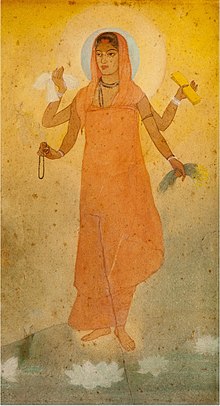Bangamata
Baṅgamātā (Bengali: বঙ্গমাতা), Mother Bengal or simply বাংলা/ Bangla, a personification of Bengal,[1][2][3][4][5] In Amar Shonar Bangla, the national anthem of Bangladesh, Rabindranath Tagore used the word "Maa" (Mother) numerous times to refer to the motherland, i.e. Bengal. Despite her popularity in patriotic songs and poems, her physical representations and images are rare. However, Muslims of Muslim majority Bangladesh, specially the Bangladeshi nationalists, revere a similar personification of Bangladesh as Bangamata (the "Mother Bangladesh"), though it is not as a goddess but an abstract reference to the motherland.[6][7][8][not in the source given]

In art and literature
changeIn his patriotic song, known as Aaji Bangladesher Hridoy (1905), the poet Rabindranath Tagore wrote the following depiction of Bangladesh:[9][10][11]
- When did you come out of the heart of Bangladesh,
- O, Mother dear, with such inexplicable splendour!
- It’s impossible to take away eyes from you!
- The doors of your golden temple have unlocked.
- Your right hand holds the blazing sword, the left one takes away fear,
- Smile of affection on the eyes, the third eye glaring.
- O Mother dear, how uniquely you reveal yourself!
- The cloud of your untied hair conceals thunders
- Ends of your sunlight coloured robes flutter in the horizon!
- It’s impossible to take away eyes from you!
- The doors of your golden temple have unlocked.
- When impassionately did not look up seemed
- Poor mother stayed back home , desolate, destitute.
- Your torn clothes vanish now, meagre smile disappear.
- Beams of light scatter from your feet into entire sky
- O Mother, your appearance astounds me.
- You flood the world with the flow of happiness on the distressed nights
- O the mindblower, your word of fearlessness drum the heart
- It’s impossible to take away eyes from you!
- The doors of your golden temple have unlocked.
This is most probably only picturesque details of Mother Bengal.
References
change- ↑ "Bharat Mata, more benign". The Indian Express. 15 June 2016.
- ↑ Singh, Amritjit; Iyer, Nalini; Gairola, Rahul K. (2016). Revisiting India's Partition: New Essays on Memory, Culture, and Politics. Lexington Books. ISBN 9781498531054.
- ↑ "Patriotic fervour". The Hindu. Archived from the original on 2004-04-01.
- ↑ Bose, Sugata; Jalal, Ayesha (1998). Modern South Asia: History, Culture, Political Economy (1st ed.). Psychology Press. p. 121. ISBN 978-0-415-16952-3.
- ↑ Gupta, Swarupa (2009). Notions of Nationhood in Bengal: Perspectives on Samaj, c. 1867-1905. BRILL. ISBN 9789047429586.
- ↑ Dasgupta, Tapati (1993). Social Thought of Rabindranath Tagore: A Historical Analysis. Abhinav Publications. ISBN 9788170173021.
- ↑ Paranjape, Makarand (2014). Science, Spirituality and the Modernization of India. Anthem Press. ISBN 9781843317760.
- ↑ "Symbols of Water and Woman on Selected Examples of Modern Bengali Literature in the Context of Mythological Tradition". Archived from the original on 12 December 2013. Retrieved 12 December 2013.
- ↑ "Lyric aaji bangladesher hridoy". geetabitan.com. Archived from the original on 2012-10-17.
- ↑ "Song aji bangladesher hridoy | English translation".
- ↑ "What's in a word?". The Daily Star (Opinion).